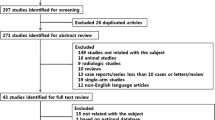Abstract
Background
The use of human acellular dermal matrix (HADM) materials in prosthetic-based breast reconstruction has gained popularity in recent years. Questions remain, however, regarding the nature and incidence of postoperative complications associated with this technique. The results reported in the available literature vary widely. This meta-analysis examines this question further with a broad review of the available literature in an effort to better define the true nature and incidence of near-term complications associated with the use of HADM in prosthetic-based breast reconstruction. It does not aim to compare this method of reconstruction to others.
Methods
A review of the available literature was performed in July 2009. The goal was to identify all previous works describing the placement of HADM at prosthetic-based breast reconstruction. Included were studies that documented the use of HADM for coverage of tissue expanders or permanent implants following therapeutic or prophylactic mastectomy. Excluded were studies that reported on the use of HADM in cosmetic breast surgery or studies that included the use of xenografts. Data collected included demographics as well as the nature and incidence of complications, with separate categories assigned for seroma, infection, flap necrosis, and “other.” Data were analyzed using Comprehensive Meta-Analysis® software (Biostat, Englewood, NJ). Raw proportions, fixed-effect models, and random-effect models were used to assess the complication rates across studies.
Results
Eleven published articles and one abstract that was later published as an article were identified. Within these 12 studies, a total of 789 breasts were identified that had undergone reconstruction with HADM. The mean follow-up was 13.7 months. Under the random-effects model, the total complication rate was 12.0%. The most common complications were flap necrosis (3.3%), seroma (3.3%), and infection (5.6%). All complications not included in these categories were set apart in a separate category, “Other,” and totaled 3.0%
Conclusion
The true incidence of postoperative complications in the near term utilizing HADM in prosthetic-based breast reconstruction appears to be approximately 12%. The incidence of long-term complications such as capsular contracture remains unknown. However, as surgical experience with HADM grows, operative techniques designed at reducing risks will mature, strategies for managing complications will advance, and more advanced products designed to reduce the incidence of complications are likely to become available.
Similar content being viewed by others
References
Rezak KM, Gillette K, Samson MC, Newman MI (2010) Attitudes toward biologic mesh in breast reconstruction: a regional survey of plastic surgeons. Plast Reconstr Surg 126(2):92e–93e
Preminger BA, McCarthy CM, Hu QY, Mehrara BJ, Disa JJ (2008) The influence of AlloDerm on expander dynamics and complications in the setting of immediate tissue expander/implant reconstruction: a matched-cohort study. Ann Plast Surg 60(5):510–513
Zienowicz RJ, Karacaoglu E (2007) Implant-based breast reconstruction with allograft. Plast Reconstr Surg 120(2):373–381
Margulies AG, Hochberg J, Kepple J, Henry-Tillman RS, Westbrook K, Klimberg VS (2005) Total skin-sparing mastectomy without preservation of the nipple-areola complex. Am J Surg 190(6):907–912
Gamboa-Bobadilla GM (2006) Implant breast reconstruction using acellular dermal matrix. Ann Plast Surg 56(1):22–25
Bindingnavele V, Gaon M, Ota KS, Kulber DA, Lee DJ (2007) Use of acellular cadaveric dermis and tissue expansion in postmastectomy breast reconstruction. J Plast Reconstr Aesthet Surg 60(11):1214–1218
Breuing KH, Colwell AS (2009) Immediate breast tissue expander-implant reconstruction with inferolateral AlloDerm hammock and postoperative radiation: a preliminary report. ePlasty 9:e16
Salzberg CA (2006) Nonexpansive immediate breast reconstruction using human acellular tissue matrix graft (AlloDerm). Ann Plast Surg 57(1):1–5
Topol BM, Dalton EF, Ponn T, Campbell CJ (2008) Immediate single-stage breast reconstruction using implants and human acellular dermal tissue matrix with adjustment of the lower pole of the breast to reduce unwanted lift. Ann Plast Surg 61(5):494–499
Spear SL, Parikh PM, Reisin E, Menon NG (2008) Acellular dermis-assisted breast reconstruction. Aesthetic Plast Surg 32(3):418–425
Becker S, Saint-Cyr M, Wong C, Dauwe P, Nagarkar P, Thornton JF, Peng Y (2009) AlloDerm versus DermaMatrix in immediate expander-based breast reconstruction: a preliminary comparison of complication profiles and material compliance. Plast Reconstr Surg 123(1):1–6 discussion 107–108
Losken A (2009) Early results using sterilized acellular human dermis (Neoform) in post-mastectomy tissue expander breast reconstruction. Plast Reconstr Surg 123(6):1654–1658
Chun YS, Verma K, Rosen H, Lipsitz S, Morris D, Kenney P, Eriksson E (2010) Implant-based breast reconstruction using acellular dermal matrix and the risk of postoperative complications. Plast Reconstr Surg 125(2):429–436
Sullivan SR, Fletcher DR, Isom CD, Isik FF (2008) True incidence of all complications following immediate and delayed breast reconstruction. Plast Reconstr Surg 122(1):19–28
Alderman AK, Wilkins EG, Kim HM, Lowery JC (2002) Complications in postmastectomy breast reconstruction: two-year results of the Michigan Breast Reconstruction Outcome Study. Plast Reconstr Surg 109:2265–2274
Acknowledgment
This study was supported in part by Synovis Surgical, Inc.
Disclosures
Dr. Newman serves as a paid consultant and/or speaker for Synovis Surgical, Inc., LifeCell Corporation, Ethicon Corporation, Mentor Corporation, and Novadaq Technologies, Inc. Dr. Samson serves as a paid consultant and/or speaker for Synovis Surgical, Inc., Ethicon Corporation, and Novadaq Technologies, Inc. Drs. Swartz, Mahoney, and Diab have no conflicts of interest or financial ties to disclose.
Author information
Authors and Affiliations
Corresponding author
Rights and permissions
About this article
Cite this article
Newman, M.I., Swartz, K.A., Samson, M.C. et al. The True Incidence of Near-Term Postoperative Complications in Prosthetic Breast Reconstruction Utilizing Human Acellular Dermal Matrices: A Meta-Analysis. Aesth Plast Surg 35, 100–106 (2011). https://doi.org/10.1007/s00266-010-9631-6
Received:
Accepted:
Published:
Issue Date:
DOI: https://doi.org/10.1007/s00266-010-9631-6




